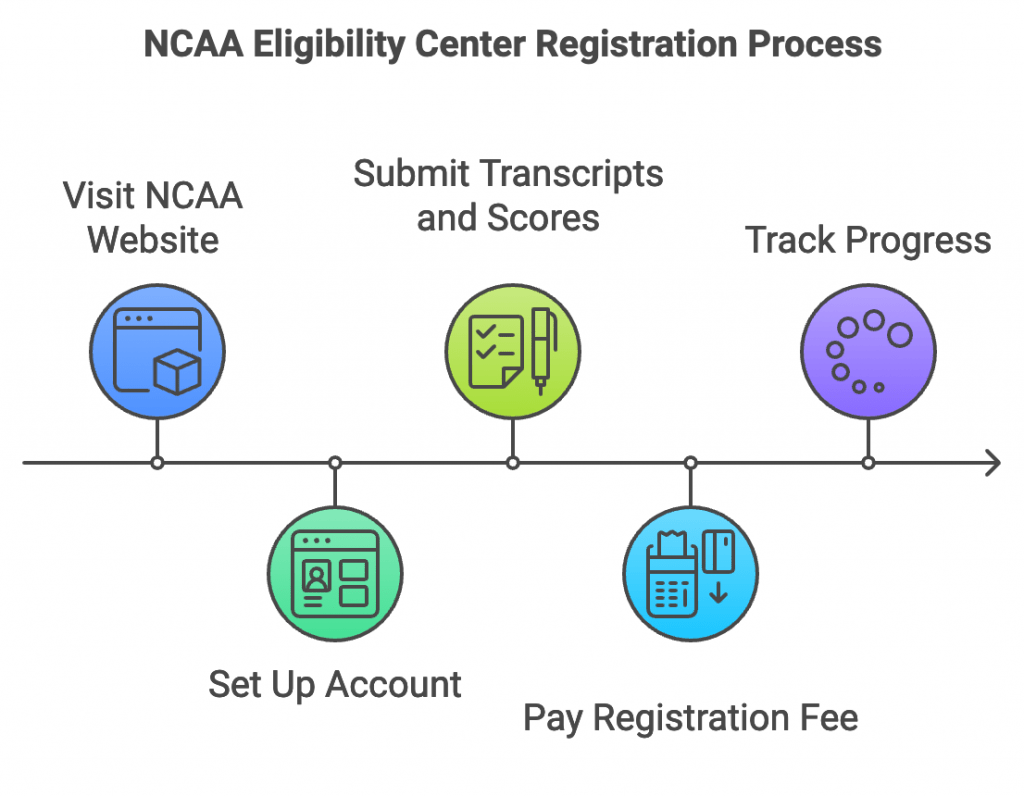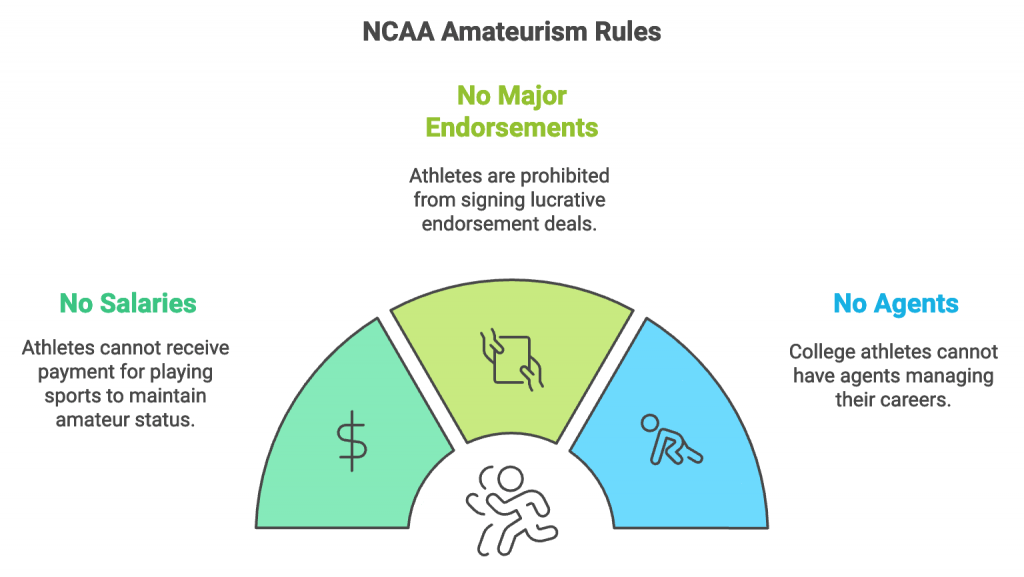Understanding NCAA Eligibility Requirements for High School Athletes
If you dream of playing sports in college, you’ve probably heard about the NCAA – the National Collegiate Athletic Association. They’re the people who make the rules for college sports, and they’re the ones who’ll help you get onto a college team. But before diving into college sports, you need to meet some requirements to be “eligible” – meaning they give you the green light to play. Don’t worry; we’re unveiling these requirements like talking to a friend – simple and fun!
What Is NCAA Eligibility, and Why Does It Matter?
Think of the NCAA as a big sports club for colleges across the U.S. They set up rules to ensure college sports are fair and safe. To play in this big club, you must meet specific “eligibility requirements,” showing that you’re ready for the college-level game. The requirements cover two significant areas:
Meeting these requirements means you’re “cleared” to play in NCAA Division I or Division II sports (more on these divisions soon). Let’s jump into what it takes to get NCAA-eligible!

NCAA Divisions – What’s the Difference?
The NCAA has three main divisions: Division I, II, and III. Each is a bit different regarding competition level, scholarships, and requirements.
For now, we’re focusing on the requirements for Division I and Division II, since you’ll need NCAA eligibility to play in these divisions.
Step 1: Get to Know the NCAA Eligibility Center
You must sign up with the NCAA Eligibility Center to play in Division I or II sports. This is like signing up for a school club – you need to fill out a form, provide some information, and pay a fee. Think of the Eligibility Center as the gatekeeper for college sports. They look at your school records, test scores, and more to ensure you’re ready to play.
Here’s How to Register:
- Head to the NCAA Eligibility Center website. This is where you start the registration process.
- Set up an account. You’ll provide basic info about yourself, your sports, and your high school.
- Send your school transcripts and test scores. Your school can help with this.
- Pay the registration fee. It’s about $90, but there are waivers if you can’t afford it.
Once you’re registered, the Eligibility Center will track your progress – kind of like a coach making sure you’re on track!

Step 2: Knock Out Your Academic Requirements
Now, let’s talk about the school part of the eligibility requirements. The NCAA wants to ensure that athletes do well in school, not just on the field or court. So, here’s what you need:
1. Core Courses:
Think of core courses as your “basic” classes that you’ll need to complete each year in high school. These are the subjects you need to pass to stay eligible:
- 4 years of English (like reading and writing)
- 3 years of Math (like algebra and geometry)
- 2 years of Natural or Physical Science (like biology and chemistry)
- 1 additional year of English, Math, or Science
- 2 years of Social Science (like history)
- 4 additional years of other courses (these can include foreign languages, philosophy, or more classes from the other subjects above)
2. Minimum GPA:
For Division I, you’ll need a minimum GPA of 2.3 in your core courses (that’s like getting mostly C’s or better). For Division II, it’s a bit lower at 2.2. Your GPA (Grade Point Average) is a number that represents how well you’re doing in your classes – the higher, the better!
3. SAT/ACT Test Scores:
You’ll also need to take the SAT or ACT, standard tests for college entry in the U.S. The score you need depends on your GPA – if you have a higher GPA, your test score doesn’t need to be as high, and vice versa.
Here’s a simple rule of thumb:
- Higher GPA = Lower Test Score Needed
- Lower GPA = Higher Test Score Needed
The NCAA has a “sliding scale” that adjusts based on your GPA, so if academics aren’t your strongest suit, you’ll need to work a bit harder on the SAT or ACT.
Step 3: Stay Amateur (Don’t Go Pro)
The NCAA also has “amateurism rules” to keep college sports fair and competitive. Being an amateur means not playing sports professionally or receiving money for your athletic skills. Here are some key points to remember:
It’s okay to play in club teams, high school leagues, and even international competitions – as long as you’re not paid. The NCAA Eligibility Center will check this when registering, so make sure your record is clean.

Step 4: Stay on Track Year by Year
For clarity’s sake, let’s break it down by grade. Here’s what you should do each year in high school to stay NCAA-eligible.
- Freshman Year (9th Grade). Start taking your core classes. It’s also a good idea to talk to your school counselor to let them know about your goals.
- Sophomore Year (10th Grade). Keep up with your core courses and consider the NCAA Eligibility Center. Check-in with your counselor again to make sure you’re on track.
- Junior Year (11th Grade). This is the year to register with the NCAA Eligibility Center. You should also take your SAT or ACT this year. Ensure your core courses are on track and your GPA is where it needs to be.
- Senior Year (12th Grade). Finish your courses, retake the SAT or ACT if needed, and send your transcripts to the NCAA Eligibility Center. This is your last check to make sure everything is in place.
Step 5: Keep Your Options Open with the NCAA “Sliding Scale”
If academics aren’t your most vital area, don’t worry! The NCAA has a “sliding scale” that helps balance your GPA and test scores. Here’s how it works:
The NCAA sliding scale gives you flexibility, so if you’re better at tests than day-to-day schoolwork, or vice versa, you still have a chance to meet eligibility requirements.

Step 6: Have a Backup Plan – Division III or NAIA
If the NCAA Division I or II requirements seem intense, remember that Division III schools and the NAIA (National Association of Intercollegiate Athletics) have different rules. Division III schools don’t offer athletic scholarships, but they still let you compete at a high level while focusing on academics. The NAIA has its set of eligibility rules, which tend to be more flexible than the NCAA.
So, if NCAA requirements feel too much, you have other options to keep playing the sport you love in college.
Make It Fun, Not Stressful
Going through the NCAA eligibility process can seem like a lot, but remember, it’s all about giving you the chance to play the sport you love while getting a college education. Take it one step at a time, stay on top of your schoolwork, and keep practicing your skills. Before you know it, you’ll attend college sports and maybe even get a scholarship!



